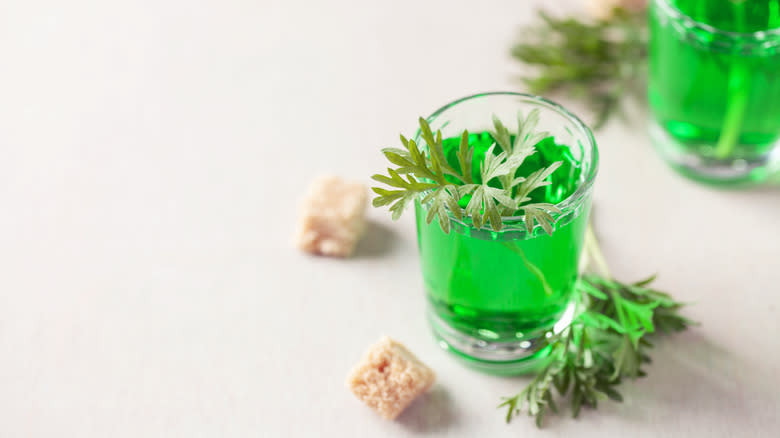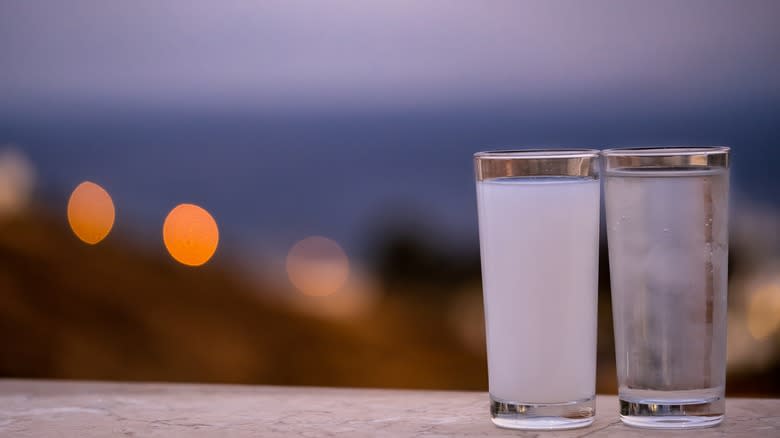The French Liquor That Got France Through Its Absinthe Prohibition

Throughout history, people have tried to blame the ills of society on many things — canoes, ankles, video games, rock music, and, of course, alcohol. But in the early part of the 20th century, the moral panic of the day wasn't over intoxicants in general; it was focused on one drink in particular: absinthe.
Absinthe, that bright green liqueur, was a favorite drink of 19th- and early 20th-century artists, including icons like Vincent Van Gogh and Oscar Wilde. It was believed to have psychoactive effects, thanks to one of its ingredients, a particular kind of wormwood, which eventually led to its being banned in several countries in Europe as well as the U.S. When France handed down its ban in 1914, it almost destroyed the town of Pontarlier, where much of the world's absinthe was made. However, one distillery was able to survive by successfully pivoting.
While most of its contemporaries were leaving France or shutting down entirely, Distillerie Guy decided to try keeping its doors open by continuing to produce its absinthe recipe, just replacing the wormwood with green anise. It named the new, colorless liqueur Pontarlier-Anis, or more popularly, Pont.
Read more: The Ultimate Vodka Brands, Ranked
A Visit From The Green Fairy

The supposed psychoactive effects of absinthe were part of its appeal to turn-of-the-century bohemians, believing it to facilitate creativity and even induce hallucinations — hence its nicknames, the "green muse" or the "green fairy." But that reputation expanded as absinthe was said to cause more and more severe symptoms, ranging from seizures to psychosis. By the early 1900s, it had become a full-blown moral panic on both sides of the Atlantic, especially when police blamed a highly publicized triple murder in Switzerland in 1905 on the two glasses of absinthe the murderer had consumed beforehand. Switzerland banned the drink shortly after, and over the next decade or so, several other countries, including France and the U.S., did so too.
Pontarlier was known as the world's absinthe capital, so the ban wrecked the local industry. The father-and-son team behind Distillerie Guy wasn't ready to close its doors and instead developed Pont. It was like absinthe in virtually every way except for color and the omission of thujone-containing wormwood. The recipe replaced it with green anise, which, unlike the star anise used to make Greek ouzo, French pastis, and Italian sambuca, is said to have a more delicate, less bitter flavor. Pont's flavor is described as clean, licorice-like, and a little spicy; when diluted with water, as with absinthe, the clear liquor turns cloudy and takes on a sort of creamy texture.
Absinthe? We Don't Know Her

Decades after the bans were put in place, scientists proved that while thujone is technically a neurotoxin, it would need to be consumed in much higher quantities — considerably more than what's contained even in an entire bottle of absinthe — to have hallucinogenic effects on an adult human. After almost a hundred years of prohibition, France repealed its absinthe ban in 2011. But Pont, having long since become a popular and established liqueur in and of itself, continues to be produced by Distillerie Guy today.
Pont is typically cut with a bit of water and sipped, but can, of course, be used in all sorts of cocktails that call for aniseed liqueur. The Islander combines scotch and sweet vermouth with a touch of aniseed liqueur, such as Pont. The Greta Garbo is essentially a classic rum daiquiri with a touch of aniseed liqueur added; the Asylum consists of equal parts dry gin and Pernod, a different aniseed liqueur, along with a touch of grenadine and water, but you could easily swap Pont in for the Pernod. However you choose to imbibe, expect a cool, refreshing flavor — but definitely no hallucinations.
Read the original article on Daily Meal.

